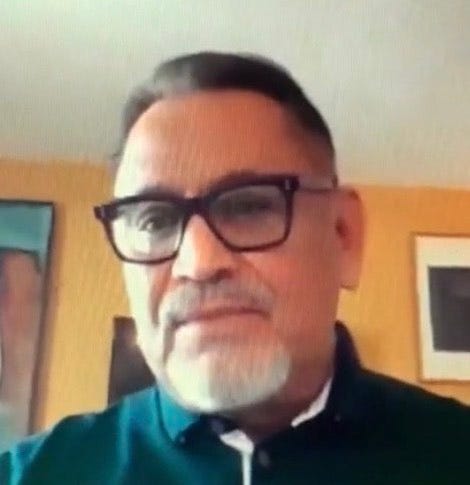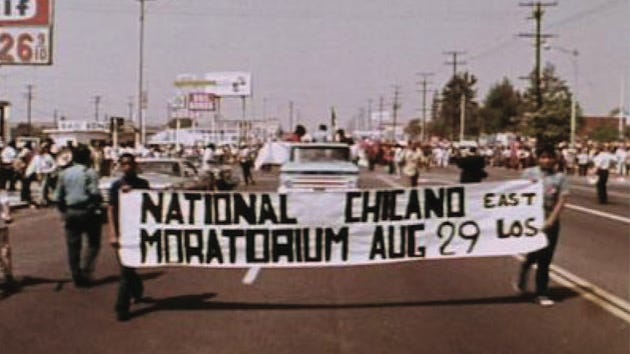
The Chicano Moratorium took place 50 years ago, on August 29, 1970. The Left Coast is pleased to feature an eyewitness article about the march by my long-time friend and Los Angeles City Councilmember Gilbert Cedillo.
The Moratorium had been called by a variety of Latinx organizations as a protest against the war, but it was also a new beginning against racism and oppression against Chicanos, Latinos, and people in color.
Many new organizations were springing up, most notably CASA (Centro de Acción Social Autónomo); MEChA (Movimiento Estudiantil Chicanx de Aztlán); La Raza Unida Party and MALDEF (Mexican American Legal Defense and Educational Fund); among many others.
The Moratorium drew around 30,000 marchers, a record for the time. On Oct. 17, 1994, Gilbert and I helped organize a march against the anti-immigrant California Proposition 187, which was estimated at 70,000 people by the L.A. Times, but could have been many more. The largest single march in the U.S. was on May 1, 2006, in downtown Los Angeles, and brought out between one and two million participants for labor and immigrant rights. – Jim
——————————

This is Chicano Power
By Gilbert Cedillo
One Saturday morning 50 years ago, I finished my household chores early and slipped out of the house to meet some friends. We were going to the Chicano Moratorium Against the Vietnam War. I was 16 years old, and this would be my first protest march. As it turned out, those were my first steps in a long march toward a more just world.
I played quarterback on Roosevelt High’s Rough Riders, which at the time was my main goal in life. That day I marched with Mario Chacon and some other friends my parents called greñudos – longhairs. An estimated 30,000 marchers made the Moratorium the largest political protest in Los Angeles history.
The Moratorium was a turning point for legions of young community activists. Marchers included political leaders Esteban Torres and Gloria Molina, attorneys Antonia Hernandez and Samuel Paz, photographer Luis Garza, and educator Maria Elena Yepes.
My greñudo friend Mario and I were roommates later at UCLA. He became an academic leader and recognized muralist in San Diego. I fought on in the labor movement and political arena.
The Moratorium, however, ended in mayhem. Sheriff Peter Pitchess’ deputies declared the speakers and music in Laguna Park an unlawful assembly and attacked families with tear gas and 3-foot riot clubs. I remember the mood turning from pride and festivity to hysteria in an instant, and thousands of unarmed demonstrators trying to get out of harm’s way.
I was an athlete and it wasn’t hard for me to hop fences. I found shelter in a house nearby packed with frantic participants from the Crusade for Justice, the leading Chicano rights organization in Denver. When things settled down, I began working my way home. I was walking up Whittier Boulevard when the booming voice of my father, a Korean War veteran and former boxer, rang out: “Get in the car!” We argued all the way home. He grounded me.
Three people died in the Moratorium’s violent aftermath, but Ruben Salazar’s death has become almost synonymous with August 29. Salazar was news director for KMEX Channel 34, the country’s preeminent Spanish language TV station, and was leading a camera crew covering the march.
Salazar also wrote a weekly column on Mexican American life for the L.A. Times, where he had been a reporter and foreign correspondent. My sociology teacher used his best-known column – “What Is a Chicano?” – to spark class discussion.
That fall I began my junior year at Roosevelt. I still made the football team, but politics was now personal. I moved from individualism and assimilation to being part of a community. This new Chicano identity was bigger than me. It was a movement, and I made a commitment to fight for social justice that I have kept ever since.
Those sharp and vivid memories have inspired me every day for 50 years. I can see the progress Latinos have made in every walk of life, but I also see inequality by so many yardsticks. Our communities suffer the highest COVID infection rate and the highest incarceration rate. And 7,000 immigrant children who were torn from their parents’ arms are still in detention.
A new generation is marching against many of the injustices we protested. This will be a defining moment for countless 16-year-olds. Today’s dreamers and protesters are tomorrow’s political, civic, and cultural leaders. They are the seeds we planted and helped to blossom. This is Chicano Power.

Photo Credit: Young Gil, Roosevelt High School Year Book
YouTube: LA This Week, Channel 35, August 28, 2020 - Camera: Frank Aguilera Boom Op: Michael Hernandez Editor: Madeleine Gallagher
Today’s Gil: District 1 (Eastside) L.A. City Councilmember, former leader of Service Employees (SEIU) Local 660

———————————-
Let’s keep them coming. Please contribute $5/mo if you can; and share with friends.
———————————-
The Chicano Collection
In this documentary film, Cheech Marin reveals his passion for collecting Chicano art and shares his life's mission to elevate public consciousness of it throughout the nation and the world.
It features interviews with many of today's top Chicano/a artists, including Chaz Bojorquez, David Botello, Melesio Casas, Gaspar Enriquez, Margaret Garcia, Rupert Garcia, Carmen Lomas Garza, Raul Guerrero, Roberto Gutierrez, Wayne Alaniz Healy, Adan Hernandez, Ester Hernandez, Leo Limon, Jose Lozano, Gilbert "Magu" Lujan, Cesar Martinez, Frank Romero, Alex Rubio, Marta Sanchez, Eloy Torrez, Jesse Trevino, John Valadez, Patssi Valdez, Vincent Valdez, and George Yepes.
It also features discussions of work by Carlos Almaraz, Richard S. Duardo, and Artemio Rodriguez. Interviews also include those by Raul Pacheco of Ozomatli, David Hidalgo and Cesar Rojas of Los Lobos, museum professionals, gallery owners, art dealers, and project team members and supporters.
Produced to accompany "The Chicano Collection," an archival print project by Richard S. Duardo of Modern Multiples in partnership with Cheech Marin and Melissa Richardson Banks (as well as a subsequent traveling exhibition produced and managed by Melissa Richardson Banks), the film describes the personal journeys and viewpoints of the 26 featured artists and their struggle for acceptance by American art museums.
Overall, this collection of stories demonstrates how Chicano art evolved from a political movement begun in the late 1960s and emerged as a legitimate art school after breaking down the walls in the fine art world to get the work seen and respected. Directed and written by Tamara Hernandez. Executive Producers: Cheech Marin, Richard S. Duardo, and Melissa Richardson Banks.
Produced by Tamara Hernandez, Melissa Richardson Banks, and Heather Flores. Music by Timoteo Aaron. Cinematography by Richard Briglia, Kristoffer Carrillo, and Tarina Reed. Editor: Garth Grinde. Motion Graphics Designer & Editor: Dan Prussmann. Sound Design: Sunny Basham. Released on November 8, 2005.
Running time: 53:05 minutes. Details on IMDB at http://www.imdb.com/title/tt1846767/



This brings back old memories. Yes 1970, I was the Pace and Freedom Party nominee for California State Controller On August 29, 1970 I was tabling at Laguna Park in East Los Angeles when tear gas started filling the park. People were running in all directions and screaming. I started packing up my stuff when I looked up to see a policeman with his baton raised moving towards me. However, someone ran by us and the officer turned and chased the other person. I don't know if it was my slow, calm movement or the fact that I was white that saved me that day, it still stands out in my mind. Today, things have not changed. The police still attack people of color as if they were in a war and people of color are the enemy. Yes, Black Lives Matter. Retraining, psychological evaluation, and weeding out of racist and/or dangerous officers need to happen now.
In solidarity.
C. T. Weber
Peace and Freedom Party of California
Legislative Committee Chair